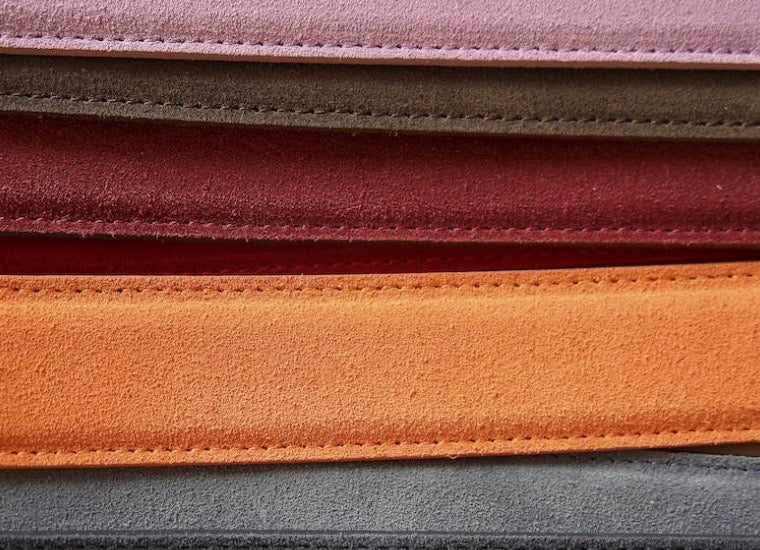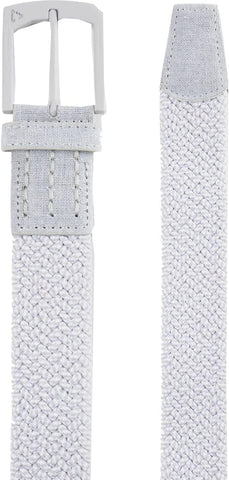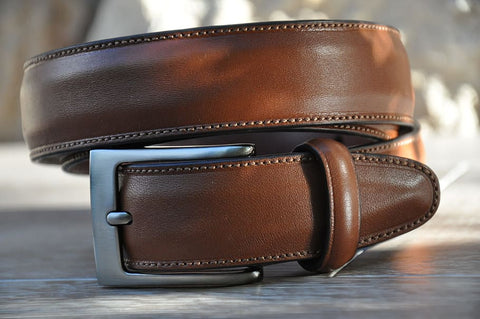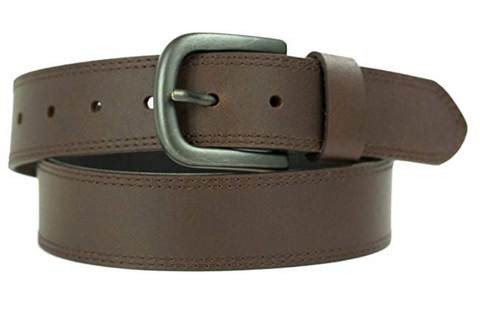
Written by Tanya Zhang
Introduction to Men's Belt Sizes
Belts are a staple accessory for men, serving both functional and fashionable purposes. However, finding the right belt and right size can be a bit perplexing due to the various factors involved. Understanding the basics of men's belt sizes can help you navigate through the options and select the perfect fit.
Because belts are an accessory that can be worn on a variety of occasions and dress codes like smart casual, business casual, semi-formal attire, and more, they are an important staple to have in a man's closet.
By understanding the principles of men's belt sizes and utilizing brand-specific sizing charts, you can confidently select a belt size that fits comfortably and complements your style.
Keep reading to learn all about belt sizing and check out our other guides on the different types of belts, and how to buy belts and match your belt to your shoes.

How Do Belt Sizes Work?
Finding the right belt size can sometimes be a confusing process. The confusion arises from several factors, including variations in sizing systems, different measurement methods, and the use of different reference points by manufacturers.
Understanding these aspects can help demystify the process and make it easier to determine the correct belt size. Firstly, the sizing systems for belts can differ between brands and countries. Some brands may use actual waist size measurements in inches or centimeters, while others may use arbitrary size numbers (such as 32, 34, 36).
This lack of uniformity can lead to inconsistency when comparing sizes between brands.

Secondly, the method of measuring the waist can vary. Some brands measure belts from the belt buckle end to the middle hole, while others may measure from the belt hole from end to end. This difference in measurement approach can affect the resulting belt size and add to confusion.
Furthermore, the inclusion of extra length in a belt beyond the waist size can vary. Some belts have additional holes beyond the measured waist size, while others do not. This extra length can impact the fit and may require adjustments when selecting a size.
We'll break down every part of belt sizes for men in this article so read on to understand how to match pants size to your waist size to the appropriate belt size.
Use Your Pant Size - The Shortcut Method
While it's not always a perfect match, you can use your pant size as a general guide to quickly choose a belt size. Here's a simple method to estimate your belt size based on your pants worn:

-
Check your pant size: Look at the tag or label inside your pants to identify your pant size. It is typically indicated as a number (e.g., 32, 34, 36) and represents the waist measurement of your pants.
-
Add or subtract inches: As a rough guideline, add 2 inches (5 cm) to your pant size to determine your belt size. For example, if you wear pants with a size 34 waist, you would generally start by looking for a belt size around 36 inches (91 cm).
-
Adjust based on personal preference: Consider your desired fit and adjust the size accordingly. If you prefer a looser fit, you might want to add an extra inch or two to your belt size estimate. If you prefer a tighter fit, subtract an inch or two.
This belt size method provides a rough and quick estimate and may not always be accurate due to variations in sizing between brands and individual body proportions.
In short, to find the right men's belt size, take your pants waist size and add two inches.
Also, measuring your waist directly with a measuring tape is the most accurate way to determine your belt size. However, using your pant size as a starting point can be a convenient and quick way to narrow down your options when selecting a belt.
How to Find Your Belt Size - A Full Step-by-Step Guide
To determine a well fitting belt size for men, you can follow these steps:
-
Measure your waist: Use a flexible, soft tape measure to measure around your waist at the point where you usually wear your belt. Make sure the tape is snug but not too tight for pants waist size.
-
Note down the measurement: Take note of the belt measurements in inches or centimeters. This measurement will be your waist size.
-
Consult a sizing chart: Different manufacturers may have slight variations in their sizing, so it's best to consult their belt size chart. Most brands provide sizing charts on their websites or on the product page for their leather belts.
-
Measure belt size: Match your waist size to the corresponding belt size on the sizing chart. Belt sizes are usually labeled with a number (such as 32, 34, 36) that represents the waist size it's designed to fit. Sometimes, leather belts are measured from the buckle end to the middle hole, so you may need to add a few inches to your waist size to get the correct belt size.

-
Consider personal preferences: If you prefer a looser or tighter fit, you can adjust the leather belts accordingly. For example, if you prefer a looser fit, you might want to go up one size from your waist measurement.
-
Try it on if possible: If you have the opportunity, try the belt size on before purchasing to ensure it fits comfortably and allows for adjustment. Or if you have an existing belt size that fits comfortably, you can measure that to determine belt size.
There may be slight variations between brands so we recommend always referring to the specific belt size chart provided by the manufacturer for the most accurate sizing information.

Things to Consider When Finding the Perfect Fitting Belt Size
When selecting your belt size, there are a few important factors to keep in mind to ensure the current belt for a proper fit and comfortable wearing experience. Here's what you should consider:

-
Waist Measurement: Measure your waist accurately using a flexible tape measure. This will serve as the starting point for determining your belt size. Make sure to measure around the area where you typically wear your belt.
-
Belt Size Chart: Consult the sizing chart provided by the specific brand or retailer you're considering. Different manufacturers may have slight variations in their sizing systems, so relying on their guidelines will help you choose the right belt size.
-
Belt Length: Consider the length of the belt beyond the buckle end. Some belts have extra length beyond the measured waist size with additional belt loops, providing flexibility for adjustment. This additional length can be beneficial if you prefer to wear your belt looser or if your waist size fluctuates.
-
Belt Width: Pay attention to the width of the belt. Different occasions and outfits may call for varying belt widths. For formal or dressy attire, narrower belts are generally more appropriate, while wider belts can complement casual or rugged styles.
Whenever possible, try the leather belt size on before purchasing it. This allows you to assess the fit and adjustability firsthand. If you're unable to try it on, check the retailer's return policy to ensure you can exchange or return the belt if it doesn't fit as expected.
By keeping these factors in mind, you can select a belt size that matches your natural waistline and measurement, suits your preferred fit, and complements your personal style, ensuring both comfort and style in your belt-wearing experience.
Different Types of Belts
There are several different types of belts available, each with its unique characteristics and intended uses.
Dress Belts

These are leather belts and are typically narrower and more formal in style. Leather belts tend to feature a simple, understated buckle. They are designed to be worn with dress pants or slacks, suits, and formal attire.
Casual Belts
Casual belts are versatile and can be worn with a wide range of outfits. They come in various materials like fabric, colors, and styles. Casual leather belts are often wider than dress belts and may feature embellishments, patterns, or decorative buckles. Casual belts like braided belts also pair well with jeans, chinos, and casual trousers like khakis for men.

Reversible Belts
Reversible belts offer versatility as they have two different colors or patterns on each side. You can flip the belt to match different outfits or occasions, providing more flexibility with fewer belts
4 Essential Belt Colors to Have
When selecting belts, there are several versatile colors to consider that can complement a range of outfits:

-
Black: A black belt is a classic and versatile choice that pairs well with formal or black tie attire and can add a sleek touch to any outfit. It's a must-have in every wardrobe.
-
Brown: Brown belts are highly versatile and come in various shades, from light tan to dark chocolate. They can be paired with both casual and dressier outfits, providing a warm and sophisticated look. Here are a few guides on how to wear a brown belt with black suit with brown shoes, blue suit with brown shoes, and a grey suit with brown shoes.

-
Tan/Natural: Tan or natural-colored belts offer a lighter and more casual option. They work well with khakis, linen pants, and other summer or casual ensembles, adding a relaxed and laid-back vibe.

-
Dark Brown: Dark brown belts provide a refined and elegant option that works well with earth-toned outfits and can add depth to both formal and casual looks.

Remember to consider your personal style and the colors in your wardrobe when choosing a belt color.
Opting for versatile options like black, brown, and tan ensures you have belts that can match a wide range of outfits while experimenting with bolder colors can help add interest and individuality to your look.
Conclusion
Selecting the optimal belt size is crucial for a comfortable and stylish fit. While using your pant size as a starting point can provide a general estimate, measuring your natural waistline and referring to the brand's sizing chart is recommended for precise measurements.
Additionally, considering your preferred fit, the type of belt, and coordinating with your outfit can further enhance your belt-wearing experience. With these guidelines in mind, you'll be able to confidently choose the optimal belt size that complements your style and ensures a secure and fashionable look.
Ready for the next guide? Read our guide to sock sizes.
FAQs about belt sizes for men
What size belt do I need for a 32 waist?
For a 32-inch waist, you would typically need a belt size around 34 inches, but it's advisable to consult the specific brand's sizing chart for more accurate measurements and adjust according to your desired fit custom size.
What size belt for a 34 waist for a man?
For a 34-inch waist, a size 36 belt is usually the best choice. As with most belts, it's recommended to select a belt size that is 2 inches larger than your waist measurement to allow for flexibility in fit.
What size is 110 in men's belts?
A belt size of 110 cm is roughly equivalent to a 44-inch waist. This size is generally intended for larger waist sizes, so a 110 cm belt will fit waist measurements between 38 and 44 inches, depending on your preferred fit.
What size belt for a 36 inch waist?
For a 36-inch waist, you should choose a size 38 belt. Like other belt sizing guidelines, it’s best to select a belt that is 2 inches larger than your waist measurement to ensure a comfortable, adjustable fit.

Comments (0)
Back to News